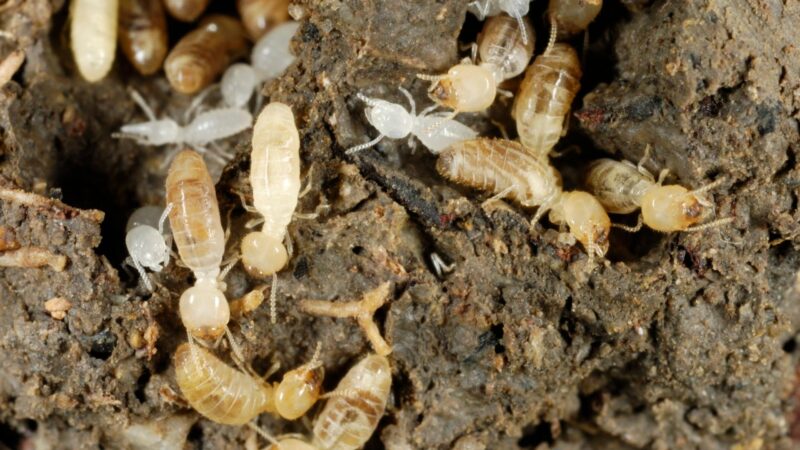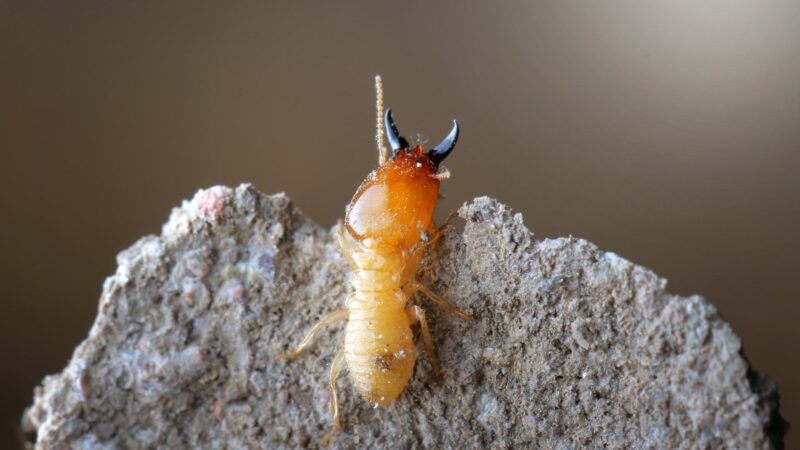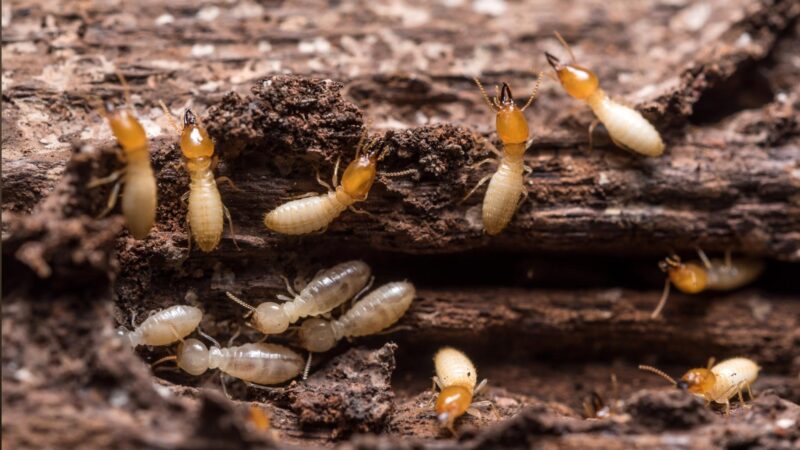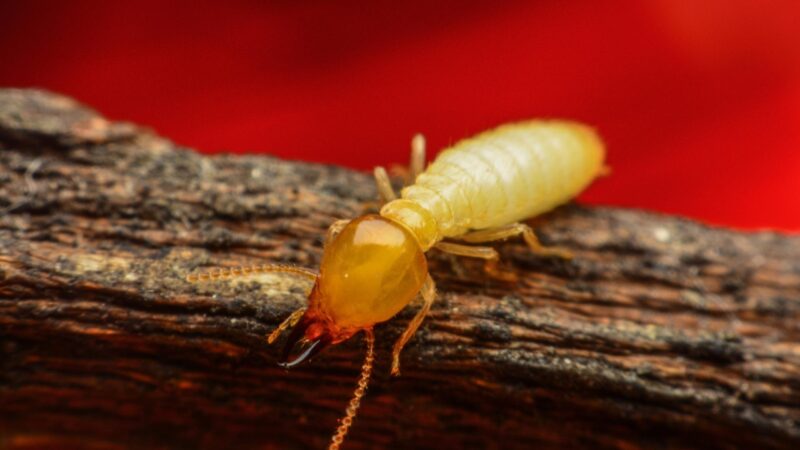It is useful to know what these notorious destroyers of wooden surfaces and materials look like at different stages in their life cycle in order to detect and eradicate termite infestations early.
Baby termites are newly hatched larvae or immature nymphs, characterized by their tiny, C-shaped bodies and grub-like appearance that resembles maggots. Immature nymphs that are fed and become well-developed will assume one of the 3 castes in a termite colony: worker, soldier, and reproductive.
This article will provide you with everything you need to learn about termites, their appearance, lifespan, entire life cycle, how much damage they can cause, what infestations could look like so you can be prepared, and more!
What Do Baby Termites Look Like?

Baby termites, otherwise known as nymphs or larvae (specifically those that have just hatched from their eggs), are tiny with a C-shaped body, grub-like appearance, and soft head capsules and mouthparts. Their appearance resembles maggots since they don’t have outer shells. As they develop, they will look more like worker termites, except that they’re a whole lot smaller.
What Size Are Baby Termites?
Baby termites are tiny—about a tenth of an inch in length.
What Do Baby Termites Eat?
Baby termites eat regurgitated food fed to them by worker termites or attendants during their first 2 weeks after hatching from their eggs. This food is cellulose that is collected from wood and chewed so the baby termites can eat it.
What Do Adult Termites Look Like?

| Type of Termite | Appearance |
| Primary reproductives (king and queen) | The king and the queen are about 1/4 to 3/8 an inch in length with a coal black to pale yellow-brown coloration and pale or brown wings. They are both characterized by large abdomens but the queen’s will further be enlarged as it develops its ovaries and reproduces. |
| Other reproductives | Swarmers (winged reproductives) are ⅜ of an inch with a black or dark brown body and silvery-colored wings that extend past their abdomen. Secondary and tertiary reproductives resemble workers but lack wing pads. |
| Soldiers | Generally, they have a transparent or creamy white coloration but have enlarged, armored heads that are darker in color compared to workers as well as large, elongated mandibles. |
| Workers | Also referred to as pseudergates, they are only about ⅛ of an inch long and are characterized by their soft bodies, creamy white color, lack of wings and eyes, bead-like antennae, and hardened mouthparts. |
What Is the Lifespan of a Termite?
- King and queen: Up to 25 years
- Workers: 10 months to 5 years
- Soldiers: Up to 5 years
- Secondary and tertiary reproductives: More than 4 years
The Life Cycle of a Termite
Termites go through a complete life cycle consisting of 3 stages: egg, nymph, and adult. Unlike other insects, termites undergo an incomplete or simple metamorphosis, which means that they don’t have a pupal stage where they enclose themselves in cocoons.
Egg
In a colony, the sexually developed adult male and female are considered the reproductives also known as the king and the queen. Unlike bee colonies, a termite colony may have numerous queens and can lay eggs altogether.
When the queen is ready to lay eggs, her abdomen enlarges to accommodate the number of eggs she can produce. A single queen can lay as many as 1,000 eggs a day, especially those in well-established colonies. Older colonies may even consist of secondary and tertiary reproductive termites, which also lay eggs but not as much as the queen.
Termite eggs look like tiny jelly beans with a translucent exterior. After the queen lays eggs, there will be a 2-week incubation period observed where the worker termites will take care of the eggs.
Nymph
After the incubation period, nymphs will hatch from the eggs and are usually located near the king and queen. Those that have just hatched and have only gone through 1 molt are also referred to as larvae.
Young nymphs are fed by worker termites with regurgitated food for the first 2 weeks of their life. This allows them to further develop and undergo a second molting to become one of the 3 different forms or castes of a termite colony: a worker, soldier, or reproductive, depending on which role the colony necessitates.
Adult
- Worker. They comprise around 90 to 98 percent of the members of the colony. Also, they are responsible for many tasks such as building nests, foraging for food, excavating chambers, caring for other caste members, repairing tunnel systems when necessary, locating and consuming wood, and cultivating fungus gardens.
Even if they reach maturity, workers can continue molting themselves throughout their lives, which allows them to achieve a new set of mouthparts. They’re generally sterile, but if they become isolated, they may molt into tertiary reproductives.
- Soldier. Comprising around 2 to 10 percent of a termite colony, soldiers play a solely defensive role against potential intruders such as ants, birds, spiders, and even other termites. Then, they will respond immediately to breeches in the colony’s tunnel walls or any other attacks made toward the colony.
Soldiers use their mandibles to puncture, slash, and even crush their enemies. Higher termites, such as those belonging to the family Termitidae, are capable of producing defensive secretions against opponents. The mode of delivery varies between species—it can be either squirted from a distance or by autothysis, which refers to when the termite self-rupts its body wall, resulting in its death along with the enemy.
Once fully developed, soldiers have already reached the final molt in their entire lifespan. Like workers, they are also incapable of reproduction.
- Reproductives. There are mainly 2 kinds of reproductives in a colony: the primary reproductives (king and queen) and the winged reproductives (also called swarmers or alates). However, well-developed colonies may have additional reproductives called secondary and/or tertiary reproductives.
| Type of Reproductive | Role |
| Primary (king and queen) | The king and queen are swarmers from a previous colony that have ventured out, found mates, and are looking to establish a new colony. They will break off their wings to start constructing the nest. The queen is responsible for laying eggs that will eventually turn to colony members. |
| Winged (swarmers or alates) | Swarmers make up less than 1 percent of the entire colony and are not produced unless the colony is well-established. They can eventually become kings and queens of new colonies as they venture out of the colonies they were born in. They are characterized by being weak and clumsy fliers, making them easy targets for potential predators. |
| Secondary | They are sexually reproductive adults that have evolved from being nymphs, have not developed true wings (hence, they are technically wingless) and are tasked to supplement egg production. They may be found both in the parent nest or in satellite nests. |
| Tertiary | These reproductives develop from workers and also lack wing pads. They are also tasked with helping increase the egg-laying capacity of the colony. |
Are Baby Termites Harmful?

Baby termites are completely harmless. They are unable to fend for themselves and rely heavily on worker termites to care for and feed them.
Can Baby Termites Cause Damage?
Baby termites can’t cause damage. Only worker termites can cause damage since they are responsible for foraging outside the colony and then bringing it back inside so that they can feed members from other castes, including baby termites. Again, baby termites are harmless.
Do Termites Go Away on Their Own?

Termites can leave by themselves but not before causing significant structural damage to households and buildings. They may also potentially come back and further destroy wooden surfaces, property, and other materials. This is why it’s important to exterminate them immediately.
How Long Does It Take for Termites to Cause Serious Damage?
It depends on the species and size of the colony. Generally, a mature and well-established colony that is made up of thousands of individual termites can consume 5 kilograms of wood in a month.
Drywood termite colonies have a slow development—even after 2 years, they may have less than 50 workers. Formosan termites, on the other hand, can destroy and consume wood at a faster rate compared to other species since they have large colonies that can grow up to 1 million individuals. For subterranean termites, it may take several months or years to cause significant damage.
Termites, regardless of species, can infest structural wood, molding, drywall, paneling, and furniture.
What Does A Termite Infestation Look Like?
- Subterranean termite infestation is characterized by a fecal-soil mixture outside homes and buildings, as well as the presence of live termites. They may also nest in wood, however, provided that they are constantly wet and warm. The soil will look moist if they are actively infesting and dry if the infestation is relatively old.
- For drywood termite infestations, the usual symptom is the accumulation of tiny, brown fecal pellets that collect in the small holes in the infested wooden surfaces and/or inside or beneath infested furniture.
- Locating signs of dampwood termite infestations is a little difficult as they don’t usually leave behind visible evidence. They neither produce mud tubes nor create open holes in wood. A good way of knowing is to tap wood, and if it sounds hollow or feels soft, chances are there might be an infestation.
- Signs of an infestation of Formosan termites include large carton nests located in attics, trees, and wall voids. Bulges, damp or moist patches, and blistered paint or wallpaper on floors, walls, and doors may also indicate termite activity.
- Evidence of conehead termite infestation includes the nest they have constructed and tunnels on nearby vegetation or structures. Tunnels are more visible as they are often numerous since these termites are surface feeders.
Related: How to Get Rid of Subterranean Termites? | Control and Prevention
Baby termites are tiny grubs that are fed regurgitated food by worker termites to develop into one of the 3 castes in the termite colony. Adult termites can assume the role of reproductives, soldiers, and workers depending on the role the colony needs. It is important to note that only worker termites can deal real damage to wooden surfaces, areas, and materials.
List of Sources
Cabrera, B. J., et al. (2021). Formosan Subterranean Termite. University of Florida.
Chan, W. H., Pereira, R. M., Koehler, P. G. (2022). Drywood and Dampwood Termites. University of Florida.
Hopkins, J. D. Subterranean Termite Identification and Biology. University of Arkansas.
Termites. (2020). Iowa State University.
Termites and Ants. Maryland Department of Agriculture.
- Bed Bug Surge 2025: How to Detect, Prevent, and Safely Eliminate Infestations in Top U.S. Cities - June 18, 2025
- Asian Needle Ants Invade US Homes: 2025 Guide to Identification, Risks, and Effective Control - June 11, 2025
- New World Screwworm Alert: How US Livestock Owners Can Prevent Outbreaks and Protect Herds [Summer 2025 Update] - June 8, 2025
